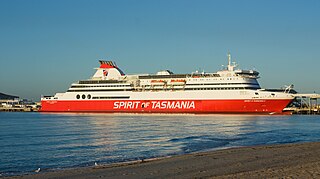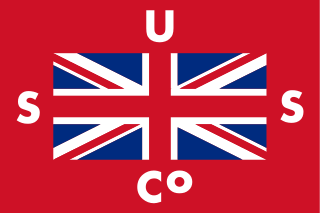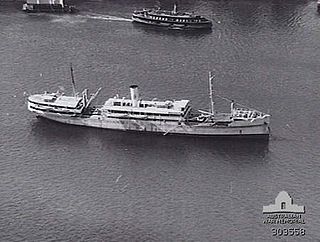
Bass Strait is a strait separating the island state of Tasmania from the Australian mainland. The strait provides the most direct waterway between the Great Australian Bight and the Tasman Sea, and is also the only maritime route into the economically prominent Port Phillip Bay.
The history of Tasmania begins at the end of the Last Glacial Period when it is believed that the island was joined to the Australian mainland. Little is known of the human history of the island until the British colonisation of Tasmania in the 19th century.

The MS Theofilos was a passenger/vehicle ferry built at the Nobiskrug shipyard in Rendsburg, Germany in 1975.

The Bass Strait Triangle is the waters that separate the states of Victoria and Tasmania, including Bass Strait, in south-eastern Australia. The term Bass Strait Triangle appears to have been first used following the disappearance of Frederick Valentich in 1978 although the region had a bad reputation long before that.
The North Mount Lyell disaster refers to a fire that broke out on 12 October 1912 at the Mount Lyell Mining and Railway Company operations on the West Coast of Tasmania, killing 42 miners. The mine had been taken over from the North Mount Lyell Company in 1903.

The North Mount Lyell Railway was built to operate between the North Mount Lyell mine in West Coast Tasmania and Pillinger in the Kelly Basin of Macquarie Harbour.
Pillinger is an abandoned port and townsite in Kelly Basin, on the south eastern side of Macquarie Harbour on the West Coast of Tasmania.

Huddart Parker Ltd was an Australian shipping company trading in various forms between 1876 and 1961. It was one of the seven major coastal shippers in Australia at a time when shipping was the principal means of interstate and trans-Tasman transport. The company started in Geelong, but in 1890 shifted its offices to Melbourne. By 1910 Huddart Parker had grown to rank 24th of the top 100 companies in Australia by asset value. Several of the company's ships served in World War I and World War II. Huddart Parker ceased to be an independent company in 1961, when it was taken over by Bitumen and Oil Refineries Australia Limited.

TT-Line Company Pty Ltd, better known by its trading name Spirit of Tasmania is a company which has been operating ferries from mainland Australia to Tasmania since July 1985. The company was separated from the Tasmanian Government's Department of Transport in 1993, becoming a government business enterprise wholly owned by the Government of Tasmania where it was then named Spirit of Tasmania in August 1993.
Neva was a three-masted barque launched in 1813. She made two voyages transporting convicts to Australia. On her second voyage carrying convicts she wrecked in Bass Strait on 13 May 1835. Her loss was one of the worst shipwrecks in Australian history; 224 people died.

Tasmanian Steamers Proprietary Limited was a company that operated passenger ferries across the Bass Strait from 1921 to 1959. It was jointly owned by the Union Steam Ship Company and Huddart Parker.

SS Taroona was built in Linthouse, Glasgow by Alexander Stephen & Sons for Tasmanian Steamers, Australia. She was a steam turbine ship capable of 18 knots, but typically operated at 16 knots for better fuel economy.

Union Steam Ship Company of New Zealand Limited was once the biggest shipping line in the southern hemisphere and New Zealand's largest private-sector employer. It was incorporated by James Mills in Dunedin in 1875 with the backing of a Scottish shipbuilder, Peter Denny. Bought by shipping giant P&O around the time of World War I it was sold in 1972 to an Australasian consortium and closed at the end of the twentieth century.

HMS Nairana was a passenger ferry that was requisitioned by the Royal Navy (RN) as a seaplane carrier in 1917. She was laid down in Scotland in 1914 as TSS Nairana for the Australian shipping line Huddart Parker, but construction was suspended after the outbreak of the First World War. Following resumption of work, the ship was launched in 1915, and converted to operate wheeled aircraft from her forward flying-off deck, as well as floatplanes that were lowered into the water. She saw service during the war with the Grand Fleet, and in 1918–19 supported the British intervention in the Russian Civil War.

HMAS Goorangai was a 223-ton auxiliary minesweeper of the Royal Australian Navy (RAN). She was built in 1919 for the Government of New South Wales, then sold in 1926 to the fishing company Cam & Sons. The trawler was requisitioned for military service following the outbreak of World War II, converted into a minesweeper, and assigned to Melbourne. She was sunk in an accidental collision with MV Duntroon in 1940, becoming the RAN's first loss of World War II, and the first RAN surface ship to be lost in wartime.

Bass Strait Ferries have been the ships that have been used for regular transport across Bass Strait between Tasmania and Victoria in mainland Australia, as well as the various attempts to link Tasmania with Sydney. Historically, some regular shipping services in the twentieth century linked Sydney, Melbourne and Hobart with the Bass Strait ports: Launceston's various port locations, Devonport and Burnie. The distinction between coastal shipping and Bass Strait ferry has been blurred at times.
HMAS Coogee was a passenger ferry that briefly served as a Royal Australian Navy armed patrol vessel and minesweeper in the latter part of the First World War. She was launched in 1887 and scuttled in 1928.
Tasmanian Steam Navigation Company Limited was an Australian steaming company, formed in Hobart in 1853 and defunct in 1922 after a series of acquisitions. It operated a shipping service from Tasmania to the Australian Mainland, later expanded to New Zealand.

SS Mactan was launched 28 December 1898 as the passenger/cargo ship North Lyell for North Mount Lyell Copper Co.Ltd. intended for service between the west coast of Tasmania and Melbourne. The company no longer needed the ship on delivery in 1899 with resulting sale to Union Steamship Company of New Zealand Ltd. and renaming as Moura. In 1915 upon sale to the Douglas Steamship Company, Ltd. of Hong Kong she was renamed Hai Hong. Upon sale to Philippine operators in 1928 the ship gained the final name Mactan.
This page is based on this
Wikipedia article Text is available under the
CC BY-SA 4.0 license; additional terms may apply.
Images, videos and audio are available under their respective licenses.












